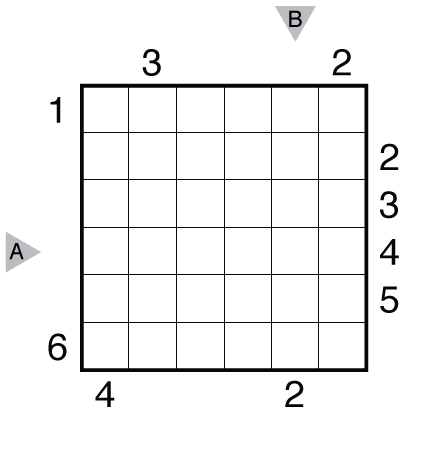Dr. Sudoku Prescribes #31 – Skyscrapers

or solve online (using our beta test of Penpa-Edit tools)
Theme: A little of everything — the rows have clues from 1 to 6.
Rules: Standard Skyscrapers rules.
Answer String: Enter the 4th row from left to right, followed by a comma, followed by the 5th column from top to bottom.
Time Standard: Skyscrapers Grandmaster = 1:00, Master = 1:45, Expert = 3:30
Solution: PDF

Skyscrapers and Battleships are two of my worst puzzle types. I get stuck on the intro pages of Battleship Sudoku. I just can’t wrap my head around that type. And Skyscrapers gives me fits were I bifurcate everywhere. I look forward to tackling these two types and learning from it.
I’m not sure my Wednesday Skyscrapers is as good a learning puzzle – it has a few more tricks than a straight-forward puzzle like this one – but I hope trying these out, and then seeing the puzzle broken down on Sunday in the Ask Dr. Sudoku gets you a little closer to passing these hurdles.
Have solved a few skyscraper types before and dont like these skyscraper type puzzles at all.
There seems to be too much of a “whether this number goes into this cell type strategy”in these type puzzles.Tired me to the core and took the fun out of the puzzle.
10 :21 to complete the easiest puzzle of the week.Things not looking good ……
I actually find that the logic in skyscrapers, like Jack Bross says, is usually there to be found without guessing, but it may be more indirect at first until you learn all the rules. On the other hand, puzzles like Battleships almost always are about guessing. And in that style people seem to accept it and still enjoy it. Curious to hear how different people experience different puzzles.
On the question of bifurcation or trial-and-error in Skyscrapers: one of the advantages of a site like Grandmaster Puzzles is you can be pretty secure in the knowledge that there is a nice clean logical solution to these skyscrapers. The puzzles at Motris’ old blog are also good for practice, as are the puzzles by Roland Voigt (Hausigel).
If you find yourself bifurcating a puzzle that you are pretty sure doesn’t really require it, take it as a learning experience. Follow both paths, and think carefully about the one that doesn’t work. What caused the contradiction, and how could you have spotted it? Is it something to look for generally?
In general, I think mastering skyscrapers is pretty subtle. The starting points are actually pretty obvious. A clue like a “5” (in a 6×6) tells you that the 6 has to be in one of the last two entries, the first entry must be a 1 or 2, and greatly restricts what happens in the middle. Looking for where the 6’s go is often a good start. If you can narrow down a cell to only 2-3 numbers, it’s often worth penciling that in. But in my opinion (as a second-rate solver), skyscrapers doesn’t come down to “tricks” (the way, say, slitherlink often does) and is a pretty pure test of puzzle logic.
Learned a new word today 🙂
bifurcate = resembling a fork; divided or separated into two branches
Ah, that’s what I call “posit” and “admit”.
(Terminology borrowed from backtracking logic for error handling in software development)
Posit = following a specific path (in sudoku for example, lets assume this particular cell contains a specific digit).
Admit = deduce that this assumption is false when that path leads to a contradiction.
In general I don’t like puzzles that require this type of logic. If the ‘posit’ path is too deep it feels like trial & error…
At least how I use the term, “bifurcate” is specifically a posit or guess with two choices, so when one fails you learn something else for sure.
I’ll say “guess” or “trial and error” or “brute force” when it is more of a posit that seems to have many choices but I’m looking to find the part of the puzzle that is hard to satisfy.
Bifurcations are all you should ever do on a sudoku or skyscrapers. Broader guesses work on things like Battleships if you can keep track of them well.
In my experience, trial and error is very rarely needed in hand-made Skyscraper puzzles, and I trust Thomas to have this week’s puzzles designed in a way that no guessing of any kind is required.
On the other hand, I find that a bifurcation may well be the fastest way to solve a Skyscraper puzzle. In the heat of a contest, I occasionally prefer to use trial and error instead of cold logic simply because it saves time. Still, I am trying to avoid it, and very often it can be avoided.
RV
Indeed, I also find when stuck on a skyscrapers at, say, a WPC, that bifurcation is the right competition approach (which is needless to say a bit frustrating). With only 36 or 49 numbers usually to specify, sometimes guessing just the one you need saves you a minute or more of time even if you guess wrong and the other case is true.